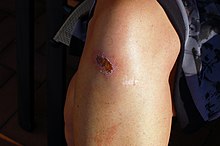Exudate (medicine)
As exudate (to Latin exsudare , "sweat", "drain") is called (mostly in medicine flammable related) secretions, as opposed to non-inflammatory transudation . The discharge of fluid is called exudation .
For superficial wounds (eg abrasions) leads coagulated exudate and its drying up to form a crust, popularly also Grind , bark , Bratze , (wound) scab , Raue or cries called. It is part of the wound healing process . Superficial wounds that are difficult to heal, as well as chronic wounds that constantly secrete large amounts of exudate, are also referred to as weeping wounds . A complete crust cannot form on them.
If the exudate collects inside the body in a cavity that has not been preformed (previously non-existent), this is referred to as a seroma (non-purulent) or abscess (purulent) if the body succeeds in encapsulating it. Unrestrained purulent spread is called phlegmon . If, on the other hand, the exudate flows into existing body cavities, it is referred to as an effusion , a purulent exudate is then called empyema .
Emergence
Exudate is caused by inflammation , for example in infections, autoimmune diseases and tissue injuries . The walls of the hair vessels become permeable for macromolecules and cells to allow defense cells and humoral components of the immune system to reach the site of the inflammation. The body tries to secrete pathogens and dead tissue .
Even malignant tumors (cancers) can cause exudates to so-called malignant effusions and (in lung cancer or breast cancer) to be pleural effusions may result. A pulmonary embolism can also lead to an exudate-related pleural effusion. The formation of exudates can also be related to the effects of drugs or radiation-induced .
Components
Exudate contains admixtures of proteins , blood , cells or cell debris and, in the case of inflammation, also microorganisms , leukocytes and the body's own scavenger and defense cells ( macrophages ).
Exudates contain more than 30 g / l protein (including enzymes ), glucose and other blood components. Exudates with a high percentage of cells and cell debris are purulent .
In order to determine the components, a swab can be taken from skin wounds . Analysis of this can provide information about whether antibiotic treatment makes sense.
Clinical pictures
Individual evidence
- ↑ Reinhard Büttner, Carlos Thomas: General Pathology . 3rd, expanded edition. Schattauer, Stuttgart 2003, ISBN 3-7945-2229-X , p. 142 ( limited preview in Google Book Search [accessed November 18, 2014]).
- ↑ Werner Böcker (Ed.): Pathology . 4th, completely revised edition. Elsevier, Urban & Fischer, Munich / Jena 2008, ISBN 3-437-42382-7 , pp. 132 ( limited preview in Google Book Search [accessed November 18, 2014]).
- ↑ Duden online: Call
- ↑ Berthold Jany, Tobias Welte: Pleural effusion in adults - causes, diagnosis and therapy. In: Deutsches Ärzteblatt. Volume 116, Issue 21, (May) 2019, pp. 377-385.
